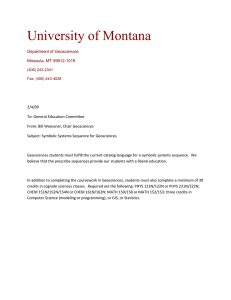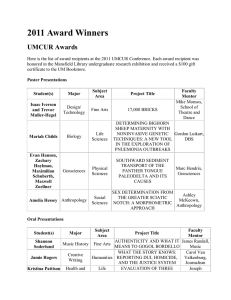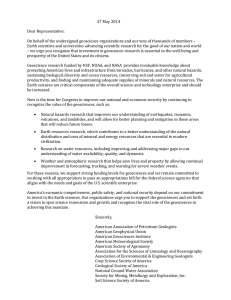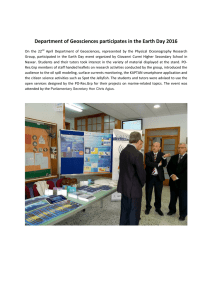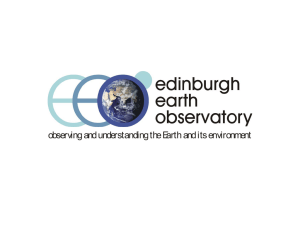Perspectives from current Grid projects and GIS Mike Mineter Research Fellow
advertisement
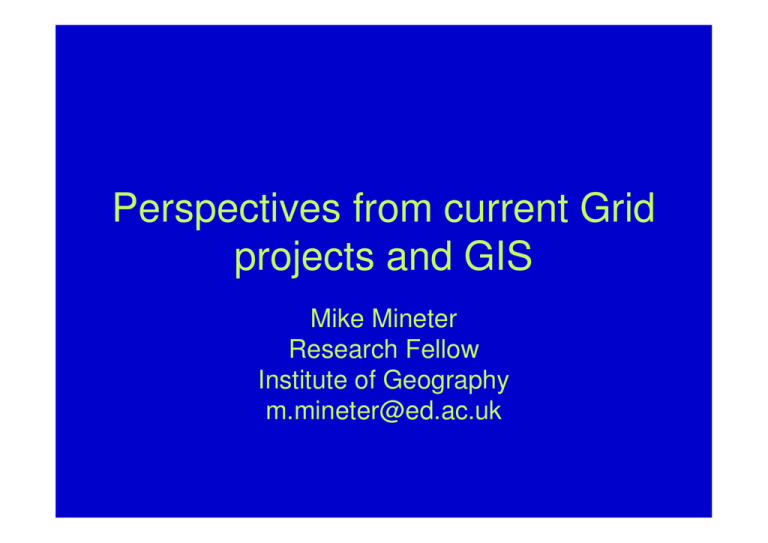
Perspectives from current Grid projects and GIS Mike Mineter Research Fellow Institute of Geography m.mineter@ed.ac.uk Overview • Period of opportunity for both Grids and geoSciences • Glimpses of some geoScience Grid projects • Developments in Geographical Information Systems • Some observations and possibilities Resonances between Grid technology and geoSciences • • • • • Early adopters of Grids had large datasets, big computation requirements and fairly clear virtual organisations GeoSciences have the first two, but also a wide range of disciplines and VO’s, and could use Grid technology both within and between these disciplines/VO’s Grid technology is emerging, and addressing these areas, where GeoSciences would challenge it GeoSciences can be a dominant application area for emerging Grid technology Grid technology can allow GeoSciences to better integrate data, computation, knowledge in improved collaborations to enhance: – research (“e-Science”) – And also efforts towards sustainability and environmental stewardship Name-dropping… • • • • • • • • GEON: Cyberinfrastructure for geoScience “ Integrated Earth System Modelling” (A term that demonstrates the need for semantics!) – GENIE (UK) – PRISM (EU), ESMF (USA) – climate – Earth Simulator (Japan) GODIVA - Ocean Diagnostics Visualisation and Analysis NEES- Network for Earthquake Simulation Engineering Climateprediction.net: Monte Carlo simulation of climate change NERC Datagrid – unified access to UK data (BADC) Datagrids for Earth Observation archives EQUATOR – sensors on Grids – Urban air pollution, Antarctic life processes GEONGrid: CyberInfrasatructure for the Geosciences Slide: 5 / MJMineter GEOsciences Network GEON - http://www.geongrid.org “GEON will help weave the separate strands of the solid Earth sciences disciplines and data into a unified fabric. This will give the geosciences an 'IT head start' for viewing the complex dynamics of the Earth system as an interrelated whole." A BIG ambitious project!! Data, computation, visualisation, collaboration, knowledge Fully 3D geodynamic models “bridge traditional disciplines”: semantics Link diverse data sets : “efforts toward defining a Unified Geosciences Language System (UGLS)” Slide: 6 / MJMineter Developments from GI Science GI data increasingly available as web services Standards from the Open GIS Consortium for maps and data …. not yet moving from Web to Grid services GI Systems: moving to component-framework architectures Use in grid-enabled GeoSciences: for visualisation of data (GEON) “wrap” GIS components within or as grid services Result: expanding set of standards, tools useful to (some) GeoSciences National Institute for Environmental e-Science GIS-Grid workshop, December Slide: 7 / MJMineter Observations • If planning “collaboratories” we must recognise the centrality of IT for sharing resources to enable: • • • • • Data management Computation Visualisation Collaboration (tools to support group-group interactions) Knowledge management: semantics • Paradigm shift from previous use of IT in geosciences, that needs to be reflected in – Strategic thinking – e.g. budgets – Interdisciplinary R&D – Technological strategies to converge with emerging Grid middleware – Model development: from programs to services to components • Grid standards open: – Scope for interoperability – Opportunities for niche developments as well as massive eScience projects – The IT world beyond science!!!!! • Synergies with other emerging technologies?? – Environmental sensors: flocks of portable instruments with GPSon-a-chip – Smart-dust?! – Clarke (Parallel Computing, Oct 2003) • We have x000 PCs in University labs, all idle overnight – Grid-enable these for trivially parallelisable problems? – (…financing the management as well as PC-Grid software! ) • A confusion to avoid: – Grids enable flexible access to shared resources that can include and link parallel processing architectures – Not (primarily) a new way to get high performance – Flexible, dynamic linking is the key! The “Killer Application”?! My suggestion: Integrate data, models, knowledge across social, economic and environmental domains What goals? To enhance the science To assess impacts of climate change To support sustainability and policy making To educate Slide: 10 / MJMineter
